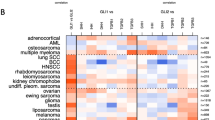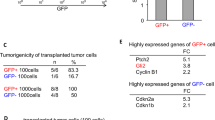Abstract
The hedgehog (Hh) signaling pathway regulates progenitor cells during embryogenesis and tumorigenesis in multiple organ systems. We have investigated the activity of this pathway in adult gliomas, and demonstrate that the Hh pathway is operational and activated within grade II and III gliomas, but not grade IV de novo glioblastoma multiforme. Furthermore, our studies reveal that pathway activity and responsiveness is confined to progenitor cells within these tumors. Additionally, we demonstrate that Hh signaling in glioma progenitor cells is ligand-dependent and provide evidence documenting the in vivo source of Sonic hedgehog protein. These findings suggest a regulatory role for the Hh pathway in progenitor cells within grade II and III gliomas, and the potential clinical utility of monitoring and targeting this pathway in these primary brain tumors.
This is a preview of subscription content, access via your institution
Access options
Subscribe to this journal
Receive 50 print issues and online access
$259.00 per year
only $5.18 per issue
Buy this article
- Purchase on Springer Link
- Instant access to full article PDF
Prices may be subject to local taxes which are calculated during checkout







Similar content being viewed by others
References
Ahn S, Joyner AL . (2005). In vivo analysis of quiescent adult neural stem cells responding to Sonic hedgehog. Nature 437: 894–897.
American Cancer Society. (2004). Cancer facts and figures.
Azzarelli B, Miravalle L, Vidal R . (2004). Immunolocalization of the oligodendrocyte transcription factor 1 (Olig1) in brain tumors. J Neuropathol Exp Neurol 63: 170–179.
Bao S, Wu Q, Sathornsumetee S, Hao Y, Li Z, Hjelmeland AB et al. (2006). Stem cell-like glioma cells promote tumor angiogenesis through vascular endothelial growth factor. Cancer Res 66: 7843–7848.
Beachy PA, Karhadkar SS, Berman DM . (2004). Tissue repair and stem cell renewal in carcinogenesis. Nature 432: 324–331.
Becher MW, Kotzuk JA, Sharp AH, Davies SW, Bates GP, Price DL et al. (1998). Intranuclear neuronal inclusions in Huntington's disease and dentatorubral and pallidoluysian atrophy: correlation between the density of inclusions and IT15 CAG triplet repeat length. Neurobiol Dis 4: 387–397.
Berman DM, Karhadkar SS, Maitra A, Montes De Oca R, Gerstenblith MR, Briggs K et al. (2003). Widespread requirement for Hedgehog ligand stimulation in growth of digestive tract tumours. Nature 425: 846–851.
Chen JK, Taipale J, Cooper MK, Beachy PA . (2002a). Inhibition of Hedgehog signaling by direct binding of cyclopamine to Smoothened. Genes Dev 16: 2743–2748.
Chen JK, Taipale J, Young KE, Maiti T, Beachy PA . (2002b). Small molecule modulation of smoothened activity. Proc Natl Acad Sci USA 99: 14071–14076.
Cooper MK, Porter JA, Young KE, Beachy PA . (1998). Teratogen-mediated inhibition of target tissue response to Shh signaling. Science 280: 1603–1607.
Dahmane N, Sanchez P, Gitton Y, Palma V, Sun T, Beyna M et al. (2001). The Sonic Hedgehog–Gli pathway regulates dorsal brain growth and tumorigenesis. Development 128: 5201–5212.
Fan L, Pepicelli CV, Dibble CC, Catbagan W, Zarycki JL, Laciak R et al. (2004). Hedgehog signaling promotes prostate xenograft tumor growth. Endocrinology 145: 3961–3970.
Frank-Kamenetsky M, Zhang XM, Bottega S, Guicherit O, Wichterle H, Dudek H et al. (2002). Small-molecule modulators of Hedgehog signaling: identification and characterization of Smoothened agonists and antagonists. J Biol 1: 10.
Galli R, Binda E, Orfanelli U, Cipelletti B, Gritti A, De Vitis S et al. (2004). Isolation and characterization of tumorigenic, stem-like neural precursors from human glioblastoma. Cancer Res 64: 7011–7021.
Hemmati HD, Nakano I, Lazareff JA, Masterman-Smith M, Geschwind DH, Bronner-Fraser M et al. (2003). Cancerous stem cells can arise from pediatric brain tumors. Proc Natl Acad Sci USA 100: 15178–15183.
Karhadkar SS, Bova GS, Abdallah N, Dhara S, Gardner D, Maitra A et al. (2004). Hedgehog signalling in prostate regeneration, neoplasia and metastasis. Nature 431: 707–712.
Katayama M, Yoshida K, Ishimori H, Katayama M, Kawase T, Motoyama J et al. (2002). Patched and smoothened mRNA expression in human astrocytic tumors inversely correlates with histological malignancy. J Neurooncol 59: 107–115.
Kleihues P, Louis DN, Scheithauer BW, Rorke LB, Reifenberger G, Burger PC et al. (2002). The WHO classification of tumors of the nervous system. J Neuropathol Exp Neurol 61: 215–225 ; discussion 226–229..
Kleihues P, Soylemezoglu F, Schauble B, Scheithauer BW, Burger PC . (1995). Histopathology, classification, and grading of gliomas. Glia 15: 211–221.
Lai K, Kaspar BK, Gage FH, Schaffer DV . (2003). Sonic hedgehog regulates adult neural progenitor proliferation in vitro and in vivo. Nat Neurosci 6: 21–27.
Lee J, Kotliarova S, Kotliarov Y, Li A, Su Q, Donin NM et al. (2006). Tumor stem cells derived from glioblastomas cultured in bFGF and EGF more closely mirror the phenotype and genotype of primary tumors than do serum-cultured cell lines. Cancer Cell 9: 391–403.
Ligon KL, Fancy SP, Franklin RJ, Rowitch DH . (2006). Olig gene function in CNS development and disease. Glia 54: 1–10.
Maher EA, Brennan C, Wen PY, Durso L, Ligon KL, Richardson A et al. (2006). Marked genomic differences characterize primary and secondary glioblastoma subtypes and identify two distinct molecular and clinical secondary glioblastoma entities. Cancer Res 66: 11502–11513.
Mokhtari K, Paris S, Aguirre-Cruz L, Privat N, Criniere E, Marie Y et al. (2005). Olig2 expression, GFAP, p53 and 1p loss analysis contribute to glioma subclassification. Neuropathol Appl Neurobiol 31: 62–69.
Oh S, Huang X, Chiang C . (2005). Specific requirements of sonic hedgehog signaling during oligodendrocyte development. Dev Dyn 234: 489–496.
Ohgaki H, Dessen P, Jourde B, Horstmann S, Nishikawa T, Di Patre PL et al. (2004). Genetic pathways to glioblastoma: a population-based study. Cancer Res 64: 6892–6899.
Sanai N, Alvarez-Buylla A, Berger MS . (2005). Neural stem cells and the origin of gliomas. N Engl J Med 353: 811–822.
Sanchez P, Hernandez AM, Stecca B, Kahler AJ, DeGueme AM, Barrett A et al. (2004). Inhibition of prostate cancer proliferation by interference with SONIC HEDGEHOG-GLI1 signaling. Proc Natl Acad Sci USA 101: 12561–12566.
Singh SK, Clarke ID, Hide T, Dirks PB . (2004a). Cancer stem cells in nervous system tumors. Oncogene 23: 7267–7273.
Singh SK, Clarke ID, Terasaki M, Bonn VE, Hawkins C, Squire J et al. (2003). Identification of a cancer stem cell in human brain tumors. Cancer Res 63: 5821–5828.
Singh SK, Hawkins C, Clarke ID, Squire JA, Bayani J, Hide T et al. (2004b). Identification of human brain tumour initiating cells. Nature 432: 396–401.
Taipale J, Chen JK, Cooper MK, Wang B, Mann RK, Milenkovic L et al. (2000). Effects of oncogenic mutations in Smoothened and Patched can be reversed by cyclopamine. Nature 406: 1005–1009.
Watkins DN, Berman DM, Burkholder SG, Wang B, Beachy PA, Baylin SB . (2003). Hedgehog signalling within airway epithelial progenitors and in small-cell lung cancer. Nature 422: 313–317.
Acknowledgements
We are grateful to Peter Konrad, Matthew Pearson and Kyle Weaver for brain specimens, to Ken Niermann, John Floyd, Khubaib Mapara, Karen Deal, Larry Pierce, Charles Stevenson and Justin Bachmann for sample collections, Darren Orten, Sam Saleh and Vandana Grover for synthesis of SAG and Michael Edgeworth for assistance with statistical analyses. This work was supported by grants from the NINDS (R01 NS051557, ME and K08 NS02133, MKC), the Burroughs Wellcome Fund (MKC) and the Doris Duke Charitable Foundation (MKC).
Author information
Authors and Affiliations
Corresponding author
Additional information
Supplementary Information accompanies the paper on the Oncogene website (http://www.nature.com/onc).
Supplementary information
Rights and permissions
About this article
Cite this article
Ehtesham, M., Sarangi, A., Valadez, J. et al. Ligand-dependent activation of the hedgehog pathway in glioma progenitor cells. Oncogene 26, 5752–5761 (2007). https://doi.org/10.1038/sj.onc.1210359
Received:
Revised:
Accepted:
Published:
Issue Date:
DOI: https://doi.org/10.1038/sj.onc.1210359
Keywords
This article is cited by
-
Novel-smoothened inhibitors for therapeutic targeting of naïve and drug-resistant hedgehog pathway-driven cancers
Acta Pharmacologica Sinica (2019)
-
GLI2 promotes cell proliferation and migration through transcriptional activation of ARHGEF16 in human glioma cells
Journal of Experimental & Clinical Cancer Research (2018)
-
Nucleolar and spindle associated protein 1 promotes the aggressiveness of astrocytoma by activating the Hedgehog signaling pathway
Journal of Experimental & Clinical Cancer Research (2017)
-
mTORC2 regulates hedgehog pathway activity by promoting stability to Gli2 protein and its nuclear translocation
Cell Death & Disease (2017)
-
Arsenic trioxide inhibits Hedgehog, Notch and stem cell properties in glioblastoma neurospheres
Acta Neuropathologica Communications (2014)



